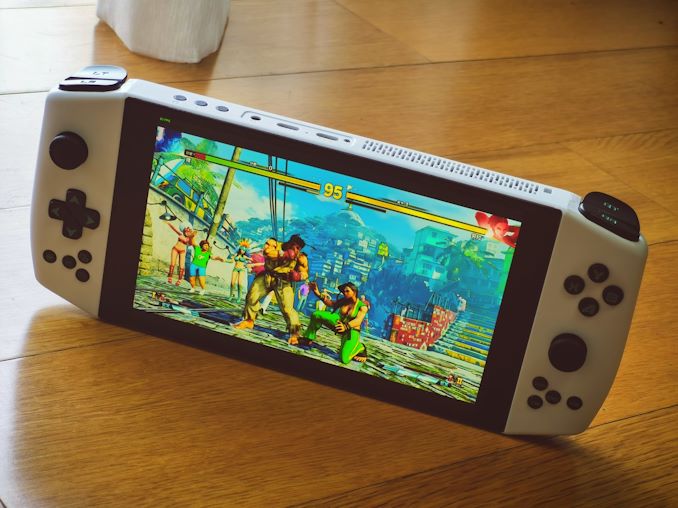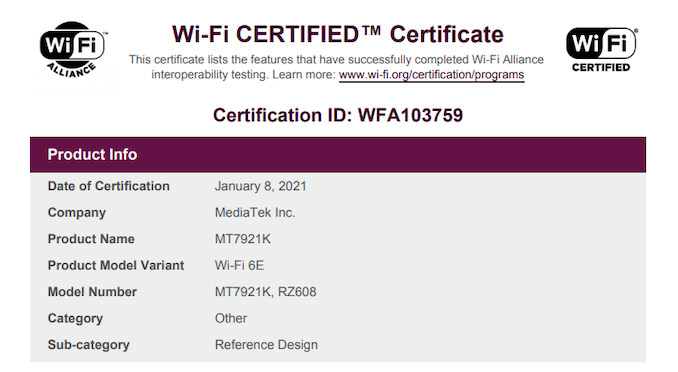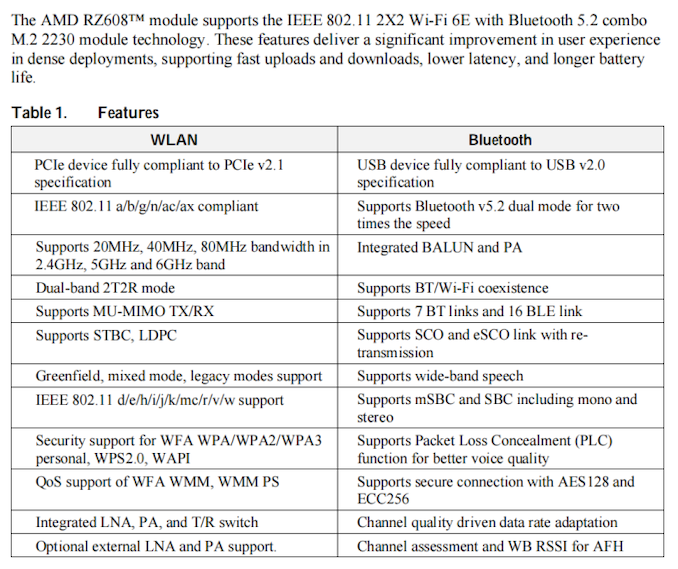AMD's Wi-Fi 6E Module: The RZ608
by Dr. Ian Cutress on May 10, 2021 5:34 AM EST
One of the elements of building a complete end-to-end solution means having all the components under one brand. The complexity of modern gadgets means that having everything made under one company is near-on impossible - especially with the wealth of IP and patents in every small segment of the modern electronic device. To facilitate the appearance of uniform branding, companies will often rebrand the components under their own name. Introducing the AMD RZ608, a Wi-Fi 6E 2x2 wireless module!
As discovered by Laczarus, the new handheld device called the AYANEO uses a wide array of AMD components, starting with the AMD Ryzen 5 4500U mobile processor which is a six-core Zen 2 chip with Vega 6 graphics. It also has a 7-inch display, and it runs a full version of Windows in a handheld device, something akin to an x86 competitor to the Nintendo Switch, albeit crowdfunded and currently shipping to initial backers.
On an update posted to the crowdfunding site on May 9th, the developers behind the project announced that their second batch of 2000 units will be using an unannounced AMD Wi-Fi 6E module. The post states that the AYANEO might very well be the first device with this module in production, and they leverage their cooperation with AMD for the integration with this part as well as troubleshooting. It is also noted that the AMD solution is slightly more expensive than the standard Wi-Fi 6 that was initially part of the design.
So here comes the crux: AMD doesn’t make the Wi-Fi module. Through our sleuthing, this is actually a rebranded MediaTek MT7921K module with an AMD logo on it. MediaTek sells the modules to AMD who brands them, but also leverages the regulatory compliance that MediaTek has already done for this product. AMD then takes over custom integration projects, sales, marketing, and support for the module. The RZ608 sold by AMD is in an M.2 2230 form factor and uses PCIe 2.1, although the AYANEO likely is using a more custom integration. There is also Bluetooth 5.2.
The use of the partnership with MediaTek will likely allow AMD to partner its mobile processors with its own branded Wi-Fi 6E solution with OEM partners when it comes to designing devices. Intel leverages the fact that it has Intel CPU, Intel Wi-Fi, Intel Thunderbolt, and Intel Ethernet as a combined sales opportunity for OEMs making devices around an Intel product, so it appears that AMD is leveraging the same ecosystem gains, albeit with rebranded components.
There was an unconfirmed rumor going around the internet last year about a collaboration between MediaTek and AMD co-creating some custom wireless designs, with some reports suggesting that the collaboration will go beyond Wi-Fi. We're not sure to what extent AMD has had any input in the design of the MT7921K / RZ608, or how much that will continue going forward. At this point I'm confident that this sits as a rebrand just for now, given the lifecycle of product development in this area, as well as the Wi-Fi certification being in MediaTek's name.

Wi-Fi Alliance Certification of MT7921K/RZ608












51 Comments
View All Comments
Matthias B V - Monday, May 10, 2021 - link
Hope they soon manage to intergrate Thunderbolt / USB 4.0 as this in my opinion is the bigger current issue not being used for lots of premium Notebooks.But yes not having to use a Intel WiFi is definetly a reasonable strategic step forward. Hope they manage their drivers well as this might be a make it or break!
nandnandnand - Monday, May 10, 2021 - link
USB4 is rumored for Rembrandt, next year's Renoir/Cezanne successor.Kevin G - Monday, May 10, 2021 - link
AMD has a socket change coming with DDR5 on the horizon. It'd be wise to add that functionality then. Following AMD's current strategy, it could just be a new feature on the IO die as needed.brakdoo - Monday, May 10, 2021 - link
How many people are really using TB? Less than 1% of people who have a TB port?I just hope DP 2.0 over USB-C will find it's way to many laptops because the problem with high-refresh 4k is going to get real once monitors are available.
DP1.3/1.4 or tunneling DP over TB/USB4 (max 40 gbps) won't be enough. Even HDMI 2.1 ain't capable of 240hz 4k. Just to put it out there: nobody likes DSC...
Spunjji - Monday, May 10, 2021 - link
"nobody likes DSC"Never even used it, no idea how good it is! 120Hz 4K seems plenty for most users for the foreseeable future.
brakdoo - Monday, May 10, 2021 - link
Look at gaming monitor trends. 120 hz won't cut it. Even the 144 - 165 hz class doesn't seem to be enough if we look at the new gaming monitors of last year.Lucky Stripes 99 - Monday, May 10, 2021 - link
Outside of competitive gaming, how important are refresh rates above 120 Hz? I would imagine that input latency would be a more important issue to tackle.brakdoo - Tuesday, May 11, 2021 - link
Outside of competitive gaming(that's a huge group of people nowadays) it's going to be about the ability to display 8k at 60 hz because many TV panels are already able to do that but there is no interface for that (only DP 2.0).Samsung is selling more 8k TVs every year but only HDMI 2.1 maximum.
rahvin - Tuesday, May 11, 2021 - link
The thing is there is very little future for those 8K panels. There is a complete lack of content in 8k and almost none in 4k. Broadcast TV is never going to move beyond 1080P(there isn't spectrum for it) and it's highly unlikely that streaming providers will provide any significant content in either 4k or 8k due to the bandwidth, storage and processing requirements.Samsung and the others are pushing 8K (and probably something bigger later) to try to drive TV sales but the reality is that once everyone's got a big screen flat TV they probably aren't going to keep buying them (and we've likely already reached that point in the US at least). It's no different than pushing 4k and 3D before that. 90% of content is 1080P or even 1080i at this point and it's unlikely to change.
But 120hz is a good thing, there is less eye strain with higher refresh rates. Just outside of specialized applications I don't see it being a selling factor that will ever draw consumer demand because most people can't tell the difference side by side.
nandnandnand - Tuesday, May 11, 2021 - link
You know what I want? An 8-inch 8K flexible OLED tablet: https://www.anandtech.com/show/13742/new-8k-oled-d...